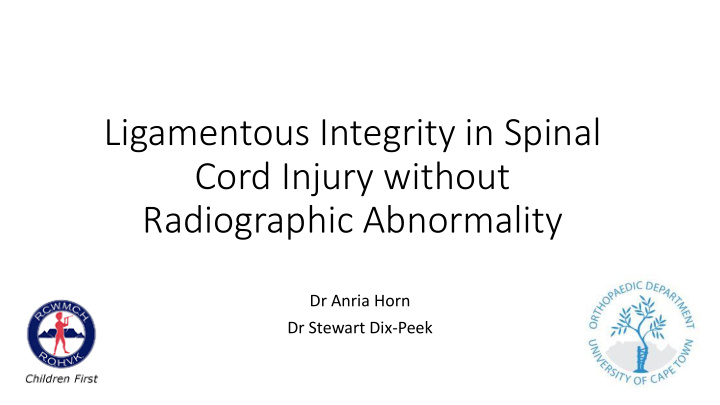



Ligamentous Integrity in Spinal Cord Injury without Radiographic Abnormality Dr Anria Horn Dr Stewart Dix-Peek
Introduction S pinal C ord I njury W ithout R adiographic A bnormality SCIWORA – Pang, Wilberger 1982 Myelopathy following trauma Plain films, CT and myelography normal
Why Children? More elastic paraspinal soft tissues Horizontal facet joints Anterior wedging of the vertebral bodies Underdeveloped uncinate processes Proportionally heavy head Adult morphology by 8 years
• Differential stretch • Occult Instability VS VS
Purpose of study Presence MRI features of occult instability following SCIWORA Need for prolonged immobilisation in these patients Prognostic value of signal change on either T1 or T2 weighted MRI and other variables such as age and level of injury
Methods Retrospective chart review 2006-2014 Patients with MRI features of SCIWORA MRI’s scrutinised for signs of ligamentous injury or instability X-rays and CT scans scrutinised for signs of instability
Age and gender Mode of injury Level involved Neurological deficit at presentation MRI findings X-ray and CT scan findings ? Immobilisation Timing of recovery Neurological deficit at final follow-up
Results 12 patients ( 9 male, 3 female) Median age 4y4m (1y3m- 8y5m) All high energy motor vehicle accidents 8 cervical spine 3 thoracic spine 1 patient with a C-spine and a T-spine lesion
Neurology 5 complete 7 incomplete 1 patient with C3 hemiplegia and paraplegia secondary to L1/2 chance #
MRI findings 7 patients had MRI signal abnormalities on T2 weighted images only 2 epidural haematomas No evidence of soft tissue injury
MRI findings 5 patients had MRI abnormalities on both T1 and T2 weighted images 1 epidural haematoma None of these patients had MRI evidence of soft tissue injury
Double level SCIWORA 8 y/o boy MVA pedestrian Paraplegia and left upper limb paresis T2 MRI lesions at C2 and T12 Arm recovered fully in 1 month Neurological recovery ongoing in both legs
X-ray findings No patient had features of instability on X-ray 2 patients with high cervical lesions had an elevated hemi-diaphragm on the affected side
Immobilisation and recurrence None of the patients with cervical lesions had rigid immobilisation following the injury No patient suffered recurrent injury despite lack of immobilisation
Neurological recovery 3 Full recovery 4 Partial recovery 5 No recovery
Age and spinal level Level of Spinal cord involvement Median Age Upper cervical spine 5 y 8 m Cervico-thoracic junction 2 years Thoracic spine 2 years
Age and severity of injury Severity of Injury Median Age Complete 2 years Incomplete 6 years
Spinal level and severity Level of Spinal cord involvement Severity Upper cervical spine 1 complete, 6 incomplete Cervico-thoracic junction 2 complete Thoracic spine 2 complete, 1 incomplete
MRI findings and neurological recovery Patients with MRI signal changes on both T1 and T2 weighted series had no neurological recovery Patients with signal change on only T2 weighted series had partial or full neurological recovery regardless of the presence of epidural haematoma
8 patients with recurrent SCIWORA 2/8 despite immobilisation 4/8 with low or no impact (basketball, sleep) Recommends more rigid immobilisation (Guilford Brace) Recommends more prolonged immobilisation (3 months vs 2 months)
189 patients with SCIWORA 21 recurrences Older children, minor transient symptoms on initial and subsequent presentation No severe ‘recurrent’ SCIWORA 14/21 recurrences whilst in rigid immobilisation Does not recommend immobilisation
The Red Cross Experience 12 patients with MRI diagnosis of SCIWORA < 8 years High energy trauma Severe neurological deficits at presentation
Occult Instability No evidence of soft tissue injury on MRI or X-rays/CT No recurrences No immobilisation
Prognosis Upper C-spine more in older children More severe injuries in younger patients Lower C-spine and T-spine injuries more severe T1 signal changes on MRI predictive of permanent, severe neurological deficit
Conclusion No evidence of occult instability of the spine following SCIWORA We therefore do not recommend immobilisation of the spine in these patients
Recommend
More recommend